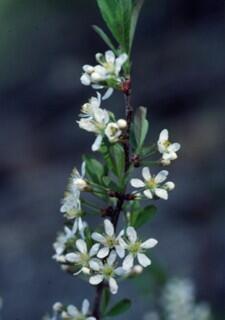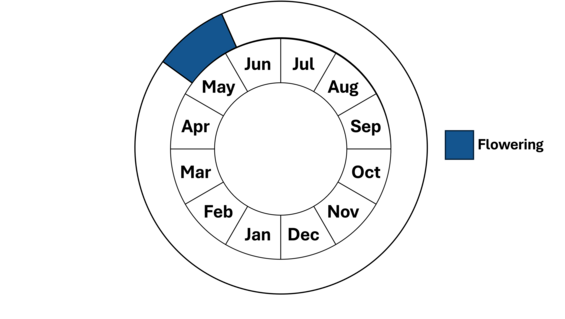- Scientific name: Prunus pumila var. depressa
- Species of Greatest Conservation Need (MA State Wildlife Action Plan)
- Special Concern (MA Endangered Species Act)
Description

Sandbar Cherry (Prunus pumila)
Sandbar cherry, a member of the Rose family (Rosaceae), is a low (up to 2 m high; 6.5 ft), deciduous shrub that forms mats or spreading bushes up to 2 m (6.5 ft) in breadth. (In Massachusetts, sandbar cherry grows only to 1 m in height; 3 ft) The main stems are prostrate, and the new shoots that grow from them are often reddish and very lustrous. Its alternate, pale green leaves are simple, narrowly oblanceolate (a bit wider toward the top), and somewhat whitened below. The five-petalled, white flowers are 1.2-1.5 cm (0.5-0.6 in) broad and occur in clusters of two to four blossoms. Flowering season is from early May to early June. The red-purple to purple-black cherries ripen in late summer or early fall. The sandbar cherry is a variety of the sand cherry (Prunus pumila L.).
Similar species include sandbar willow (Salix exigua) and other species of cherries. The sandbar willow, a shrubby, colonial species, as very long, sharply pointed narrow leaves that are from 5-10 mm (1/5 - 2/5 in) wide; in contrast, the leaves of sandbar cherry are commonly 1-2 cm (2/5 - 4/5 in) wide. Different species of Prunus may appear similar but will be found in different habitats. Finally, sandbar cherry may be separated from other varieties of P. pumila by its leaves, the growth habit of its stems, and its range and habitat. The leaves of sandbar cherry are many times greater in length than they are in width. In contrast, the Appalachian cherry (P. pumila var. cuneata) has oblong or oblong-obovate leaves. Furthermore, the Appalachian cherry variety is an erect plant and grows in dry sandy or rocky clearings. The remaining two varieties of this polymorphic species do not overlap the sandbar cherry's range.
Life cycle and behavior

Population status
Sandbar cherry is currently listed as a species of special concern in Massachusetts under the Massachusetts Endangered Species Act. There are three current populations, all in Franklin County. Sandbar cherry is also considered rare in New York, Vermont, Pennsylvania, New Jersey, and West Virginia. Forest succession and, especially, further impoundment of rivers can threaten populations of sandbar cherry.
Distribution and abundance
The documented range of sandbar cherry extends from New Brunswick west to Ontario and northern Wisconsin, and south to West Virginia, Pennsylvania, and New Jersey.

Distribution in Massachusetts. 1999-2024. Based on records in the Natural Heritage Database.
Habitat
Habitats include flood-scoured areas of islands, shores, and peninsulas in the Connecticut and Deerfield Rivers. Examples include the edge of a floodplain forest; traprock ledges in a river channel; a sand flat; riverbed cobbles and gravels at or near the floodline; a sloping rock slab just above a sandy beach; and a rock floodplain island. Somewhat atypically, one station occurs along railroad tracks beside a canal. Almost all these habitats experience annual spring flooding. Associated plants include various goldenrods, asters, willows, big bluestem (Andropogon gerardi), and Indian grass (Sorghastrum nutans). Additional associates include saplings of silver maple (Acer saccharinum), sycamore (Platanus occidentalis), and cottonwood (Populus deltoides).
Healthy habitats are vital for supporting native wildlife and plants. Explore habitats and learn about conservation and restoration in Massachusetts.
Contact
| Date published: | May 5, 2025 |
|---|